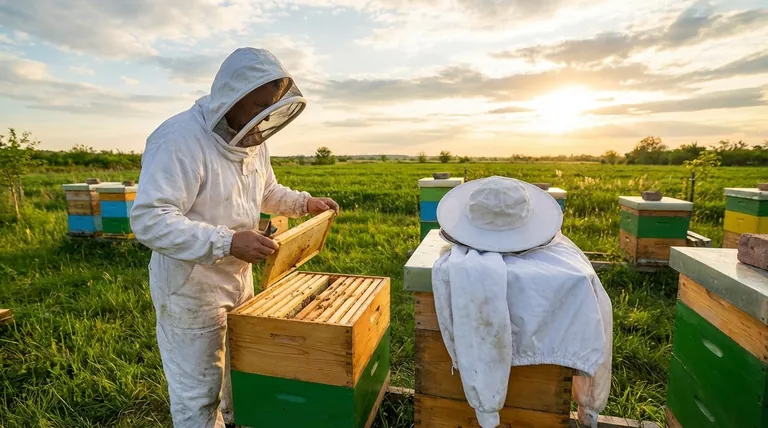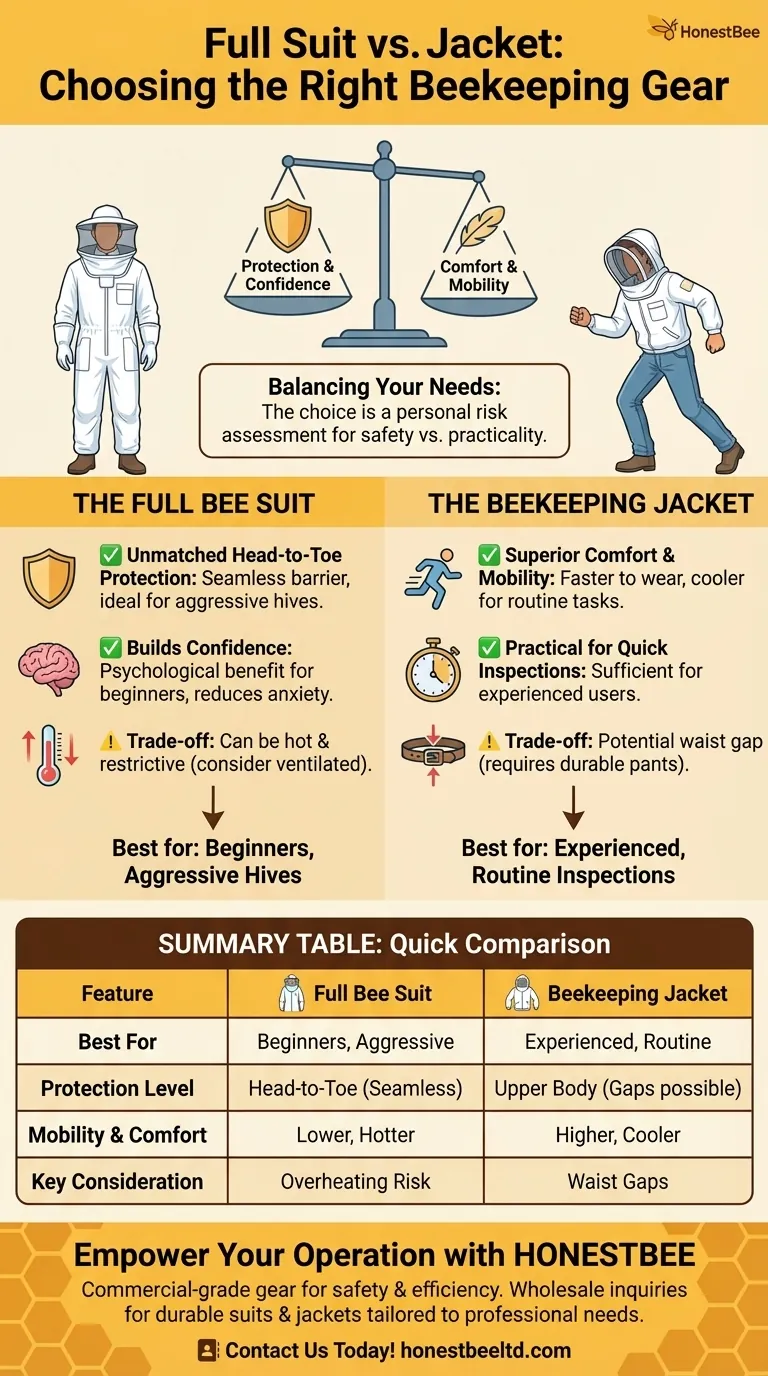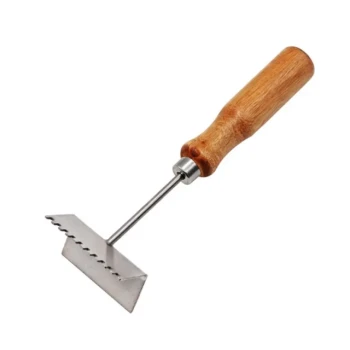In beekeeping, the choice between a full suit and a jacket comes down to balancing your personal comfort and confidence against the level of protection you require. A full suit provides complete, head-to-toe security, making it ideal for beginners or those working with potentially aggressive hives. A jacket offers greater comfort and convenience, which is often sufficient for experienced beekeepers performing routine inspections.
The decision is less about a universal "best" and more about a personal risk assessment. A full suit offers maximum security that builds confidence, while a jacket provides practical comfort and mobility for more routine work.

The Case for the Full Bee Suit
A full bee suit is a single garment that covers you from your ankles to your neck, integrating the veil into one seamless piece of protection.
Unmatched Head-to-Toe Protection
A full suit provides an unbroken barrier. This eliminates the risk of bees finding a gap between your jacket and pants, a common vulnerability.
This comprehensive coverage is especially valuable when dealing with unknown or aggressive colonies, or when performing extensive hive manipulations that can agitate the bees.
Building Confidence for the Beekeeper
For many new beekeepers, the psychological benefit of a full suit is its greatest asset. The feeling of being completely sealed off from stings allows you to move calmly and deliberately.
This confidence is crucial, as jerky, nervous movements can be perceived as a threat by the bees, making stings more likely.
The Case for the Beekeeping Jacket
A beekeeping jacket provides protection for the entire upper body and head, designed to be worn with your own durable pants.
Superior Comfort and Mobility
A jacket is significantly faster and easier to put on and take off than a full suit. This convenience is a major advantage for quick hive checks.
It is also less restrictive and often cooler, as it allows for more airflow around your lower body.
Practicality for Quick Inspections
For experienced hobbyists or those working in controlled apiaries with calm bees, a jacket offers more than enough protection for routine tasks.
Many seasoned beekeepers find a full suit to be unnecessary for the majority of their work, preferring the comfort and ease of a jacket and veil.
Understanding the Trade-offs
Neither option is perfect for every situation. Understanding their inherent compromises is key to making an informed decision.
The Suit: Protection vs. Overheating
While offering maximum protection, a non-ventilated full suit can be extremely hot and cumbersome, especially in warmer climates.
This can lead to fatigue and dehydration during long sessions in the bee yard, potentially making you less effective. Ventilated suits help mitigate this, but they come at a higher cost.
The Jacket: Convenience vs. Gaps
The primary vulnerability of a jacket is the potential gap at the waist. Bees that fall to the ground can crawl up your pants and find their way under the jacket's elastic.
Ensuring your pants are made of thick material (like jeans) and that your boots or socks cover your ankles is critical to minimizing this risk.
Making the Right Choice for Your Goal
Your selection should be a deliberate choice based on your specific context, temperament, and beekeeping style.
- If your primary focus is maximum safety and peace of mind: Choose a full suit, especially if you are a beginner or feel any anxiety around bees.
- If your primary focus is comfort and convenience for frequent, quick tasks: A high-quality jacket is likely your most practical and efficient option.
- If you are working in a hot climate: Prioritize a ventilated model, regardless of whether you choose a suit or a jacket, to ensure your comfort and safety.
Ultimately, the right gear is the gear that empowers you to work with your bees calmly and effectively.
Summary Table:
| Feature | Full Bee Suit | Beekeeping Jacket |
|---|---|---|
| Best For | Beginners, aggressive hives, maximum protection | Experienced beekeepers, routine inspections, comfort |
| Protection Level | Head-to-toe, seamless barrier | Upper body and head (requires durable pants) |
| Mobility & Comfort | Can be restrictive and hot | Greater mobility, cooler, easier to put on/take off |
| Key Consideration | Risk of overheating in warm climates | Potential for gaps at the waist |
Empower your beekeeping with the right protective gear from HONESTBEE.
Whether you manage a commercial apiary or supply equipment to distributors, having the right suit or jacket is crucial for safety and efficiency. HONESTBEE supplies durable, high-quality beekeeping suits and jackets designed for the demands of professional beekeeping.
Let our expertise help you select the perfect gear to keep your team safe, comfortable, and productive. Contact HONESTBEE today for wholesale inquiries and expert advice tailored to your operation's needs.
Visual Guide

Related Products
- Cotton Beekeeping Suit and Round Hat with Veil Bee Keeper Protective Gear
- Vented Beekeeping Jacket with Hood and Veil for Beekeepers
- 3 Layer Mesh Vented Sting Proof Beekeeping Suit with Hat and Veil
- Thick PVC Material Waterproof Anti-Slip Wear-Resistant Bee Work Shoes Boots for Garden Outdoor Utility
- Yellow Plastic Bucket Pail Perch for Beekeeping
People Also Ask
- Why is white the predominant color in bee suit designs? | Key to Hive Calm & Beekeeper Safety
- How should a beekeeping suit be hung to maintain its shape? Protect Your Investment with Proper Storage
- What should be considered regarding the color of beekeeping clothing? Ensure Your Safety and Keep Bees Calm
- How should a bee suit be cleaned? Protect Your Investment and Ensure Apiary Safety
- Do beekeeping suits completely prevent stings? Maximize Your Apiary Safety with the Right Gear



















